1998 ISUZU TROOPER wheel
[x] Cancel search: wheelPage 888 of 3573
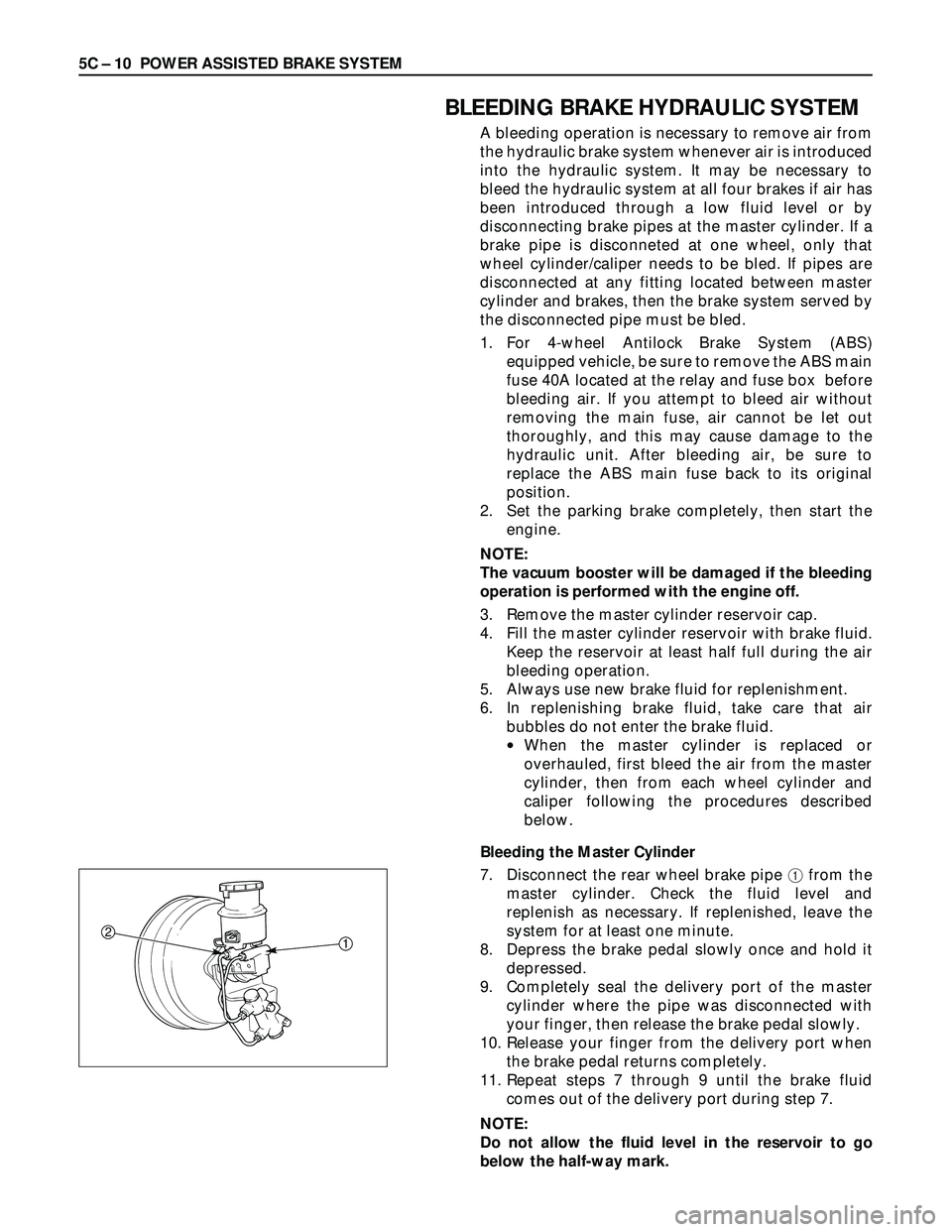
5C – 10 POWER ASSISTED BRAKE SYSTEM
BLEEDING BRAKE HYDRAULIC SYSTEM
A bleeding operation is necessary to remove air from
the hydraulic brake system whenever air is introduced
into the hydraulic system. It may be necessary to
bleed the hydraulic system at all four brakes if air has
been introduced through a low fluid level or by
disconnecting brake pipes at the master cylinder. If a
brake pipe is disconneted at one wheel, only that
wheel cylinder/caliper needs to be bled. If pipes are
disconnected at any fitting located between master
cylinder and brakes, then the brake system served by
the disconnected pipe must be bled.
1. For 4-wheel Antilock Brake System (ABS)
equipped vehicle, be sure to remove the ABS main
fuse 40A located at the relay and fuse box before
bleeding air. If you attempt to bleed air without
removing the main fuse, air cannot be let out
thoroughly, and this may cause damage to the
hydraulic unit. After bleeding air, be sure to
replace the ABS main fuse back to its original
position.
2. Set the parking brake completely, then start the
engine.
NOTE:
The vacuum booster will be damaged if the bleeding
operation is performed with the engine off.
3. Remove the master cylinder reservoir cap.
4. Fill the master cylinder reservoir with brake fluid.
Keep the reservoir at least half full during the air
bleeding operation.
5. Always use new brake fluid for replenishment.
6. In replenishing brake fluid, take care that air
bubbles do not enter the brake fluid.
•When the master cylinder is replaced or
overhauled, first bleed the air from the master
cylinder, then from each wheel cylinder and
caliper following the procedures described
below.
Bleeding the Master Cylinder
7. Disconnect the rear wheel brake pipe 1from the
master cylinder. Check the fluid level and
replenish as necessary. If replenished, leave the
system for at least one minute.
8. Depress the brake pedal slowly once and hold it
depressed.
9. Completely seal the delivery port of the master
cylinder where the pipe was disconnected with
your finger, then release the brake pedal slowly.
10. Release your finger from the delivery port when
the brake pedal returns completely.
11. Repeat steps 7 through 9 until the brake fluid
comes out of the delivery port during step 7.
NOTE:
Do not allow the fluid level in the reservoir to go
below the half-way mark.
21
Page 889 of 3573

POWER ASSISTED BRAKE SYSTEM 5C – 11
12. Reconnect the brake pipe 1to the master cylinder
and tighten the pipe.
13. Depress the brake pedal slowly once and hold it
depressed.
14. Loosen the rear wheel brake pipe 1at the master
cylinder.
15. Retighten the brake pipe, then release the brake
pedal slowly.
16. Repeat steps 13 through 15 until no air comes out
from the port when the brake pipe is loosened.
NOTE:
Be very careful not to allow the brake fluid to come in
contact with painted surfaces.
17. Bleed the air from the front wheel brake pipe
connection 2by repeating steps 7 through 16.
Bleeding the Caliper
18. Bleed the air from each wheel in the order listed
below.
LHD models:
1) Right rear caliper
2) Left rear caliper
3) Load sensing proportioning valve (only for
Europe and South Africa)
4) Right front caliper
5) Left front caliper
RHD models:
1) Left rear caliper
2) Right rear caliper
3) Load sensing proportioning valve (only for
Europe and South Africa)
4) Left front caliper
5) Right front caliper
Conduct air bleeding from the wheels in the above
order. If no brake fluid comes out, it suggests that air
is mixed in the master cylinder. In this case, bleed air
from the master cylinder in accordance with Steps 7
through 17, and then bleed air from the caliper.
19. Place the proper size box end wrench over the
bleeder screw.
20. Cover the bleeder screw with a transparent tube,
and submerge the free end of the transparent tube
in a transparent container containing brake fluid.
21. Pump the brake pedal slowly three (3) times
(once/sec), then hold it depressed.
22. Loose the bleeder screw until fluid flows through
the tube.
23. Retighten the bleeder screw.
24. Release the brake pedal slowly.
25. Repeat step 21 through 24 until the air is
compeletely removed. It may be necessary to
repeat the bleeding procedure 10 or more times
for front wheels and 15 or more times for rear
wheels.
26. Go to the next wheel in the sequence after each
wheels is bled. Be sure to monitor reservoir fluid
level.
Page 890 of 3573
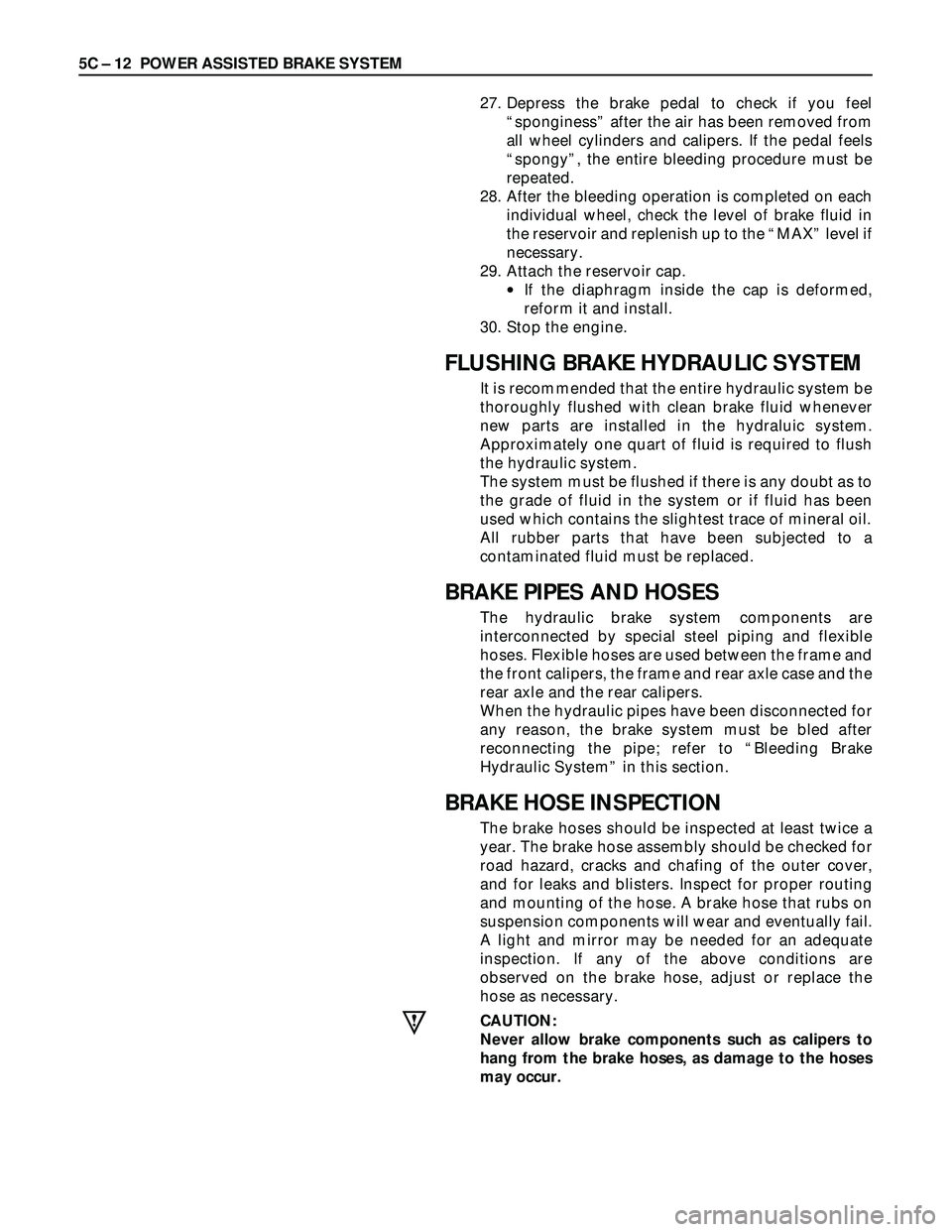
5C – 12 POWER ASSISTED BRAKE SYSTEM
27. Depress the brake pedal to check if you feel
“sponginess” after the air has been removed from
all wheel cylinders and calipers. If the pedal feels
“spongy”, the entire bleeding procedure must be
repeated.
28. After the bleeding operation is completed on each
individual wheel, check the level of brake fluid in
the reservoir and replenish up to the “MAX” level if
necessary.
29. Attach the reservoir cap.
•If the diaphragm inside the cap is deformed,
reform it and install.
30. Stop the engine.
FLUSHING BRAKE HYDRAULIC SYSTEM
It is recommended that the entire hydraulic system be
thoroughly flushed with clean brake fluid whenever
new parts are installed in the hydraluic system.
Approximately one quart of fluid is required to flush
the hydraulic system.
The system must be flushed if there is any doubt as to
the grade of fluid in the system or if fluid has been
used which contains the slightest trace of mineral oil.
All rubber parts that have been subjected to a
contaminated fluid must be replaced.
BRAKE PIPES AND HOSES
The hydraulic brake system components are
interconnected by special steel piping and flexible
hoses. Flexible hoses are used between the frame and
the front calipers, the frame and rear axle case and the
rear axle and the rear calipers.
When the hydraulic pipes have been disconnected for
any reason, the brake system must be bled after
reconnecting the pipe; refer to “Bleeding Brake
Hydraulic System” in this section.
BRAKE HOSE INSPECTION
The brake hoses should be inspected at least twice a
year. The brake hose assembly should be checked for
road hazard, cracks and chafing of the outer cover,
and for leaks and blisters. Inspect for proper routing
and mounting of the hose. A brake hose that rubs on
suspension components will wear and eventually fail.
A light and mirror may be needed for an adequate
inspection. If any of the above conditions are
observed on the brake hose, adjust or replace the
hose as necessary.
CAUTION:
Never allow brake components such as calipers to
hang from the brake hoses, as damage to the hoses
may occur.
Page 893 of 3573

POWER ASSISTED BRAKE SYSTEM 5C – 15
CHECKING LATERAL RUNOUT
1. Adjust the wheel bearing correctly.
•Refer to Front Hub and Disc in Driveline / Axle
Section.
2. Attach a dial indicator to some portion of the
suspension so that the stem contacts the rotor
face about 29 mm (1.14 in) from the rotor edge.
3. Move the rotor one complete rotation.
•The lateral runout should not exceed 0.13 mm
(0.005 in).
Maximum Runout mm (in)
0.13 (0.005)
PARALLELISM
Parallelism is the measurement of the thickness of the
rotor at four or more points around the circumference
of the rotor. All measurement must be made at 29 mm
(1.14 in) from the edge of the rotor.
The rotor thickness must not vary more than 0.010
mm (0.004 in) from point to point.
Maximum Parallelism mm (in)
0.010 (0.0004)
REPLACING FRONT BRAKE ROTORS
When installing new brake rotors, do not refinish the
surfaces. These parts are at the correct level of surface
finish.
REFINISHING FRONT BRAKE ROTORS
Accurate control of the rotor tolerances is necessary
for proper performance of the disc brakes. Machining
of the rotor should be done only with precision
equipment. All brake rotors have a minimum
thickness dimension cast into them. This dimension is
the minimum wear dimension and not a refinish
dimension. The minimum wear dimension is 24.60
mm (0.969 in). The minimum refinish dimension is
24.97 mm (0.983 in).
When refinishing rotors, always use sharp cutting
tools or bits. Dull or worn tools leave a poor surface
finish which will affect initial braking performance.
Vibration dampening attachments should always be
used when refinishing braking surfaces. These
attachments eliminate tool chatter and will result in
better surface finish.
After refinishing, replace any rotor that does not meet
the minimum thickness of 24.97 mm (0.983 in). Do not
use a brake rotor that will not meet the specification.
Minimum Wear Dimension mm (in)
24.60 (0.969)
Refinish Dimension mm (in)
24.97 (0.983)
t
Page 904 of 3573

5C – 26 POWER ASSISTED BRAKE SYSTEM
REMOVAL
Preparation:
1) Raise the vehicle and support it with suitable
safety stands.
2) Remove wheel and tire assembly.
3) Clean dirt, grease, and other foreign material off
the hose fittings at both ends.
Front/Rear Caliper Brake Hose
1. Brake Pipe
2. Clip
3. Bolt and Gasket
4. Hose
Rear Axle Brake Hose
1. Brake Pipe
2. Clip
3. Brake Pipe
4. Bolt
5. Hose
INSTALLATION
To install, follow the removal steps in the reverse
order, noting the following points. After installing the
brake hoses, bleed brakes as described in this
section.
Front/Rear Caliper Brake Hose
1. Tighten the brake pipes to the specified torque.
Brake Pipe Torque N·m(kg·m/lb·ft)
16 (1.6 / 12)
2. Tighten the bolt to the specified torque.
Bolt Torque N·m(kg·m/lb·ft)
35 (3.5 / 26)
NOTE:
•Always use new copper gaskets.
•Be sure to put the hooked edge of the flexible
hose end into the anti-rotation cavity.
Rear Axle Brake Hose
1. Tighten the brake pipes to the specified torque.
Brake Pipe Torque N·m(kg·m/lb·ft)
16 (1.6 / 12)
2. Tighten the bolt to the specified torque.
Bolt Torque N·m(kg·cm/lb·in)
13 (130 / 113)
Page 905 of 3573
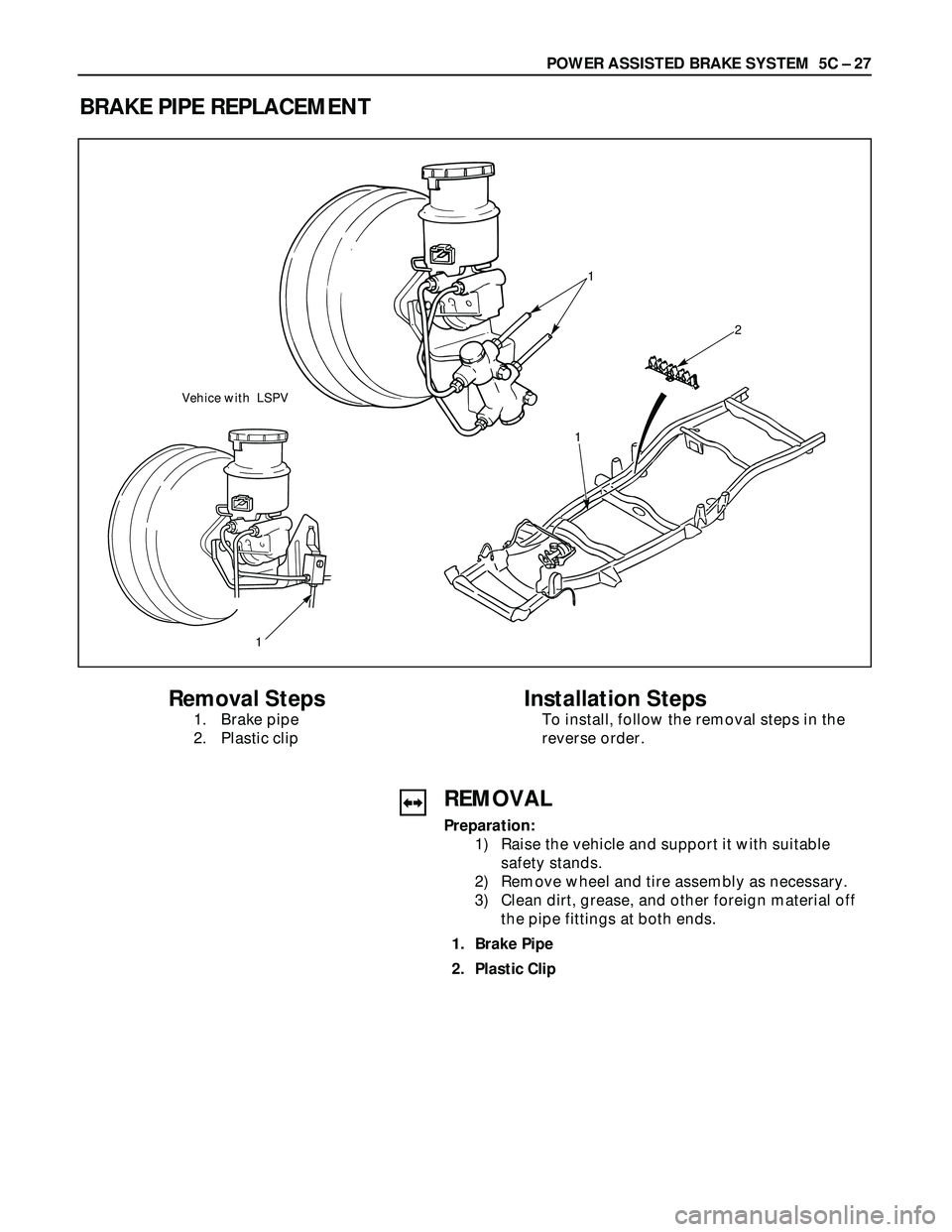
POWER ASSISTED BRAKE SYSTEM 5C – 27
BRAKE PIPE REPLACEMENT
1
12
Removal Steps
1. Brake pipe
2. Plastic clip
Installation Steps
To install, follow the removal steps in the
reverse order.
REMOVAL
Preparation:
1) Raise the vehicle and support it with suitable
safety stands.
2) Remove wheel and tire assembly as necessary.
3) Clean dirt, grease, and other foreign material off
the pipe fittings at both ends.
1. Brake Pipe
2. Plastic Clip
1 Vehice with LSPV
Page 906 of 3573
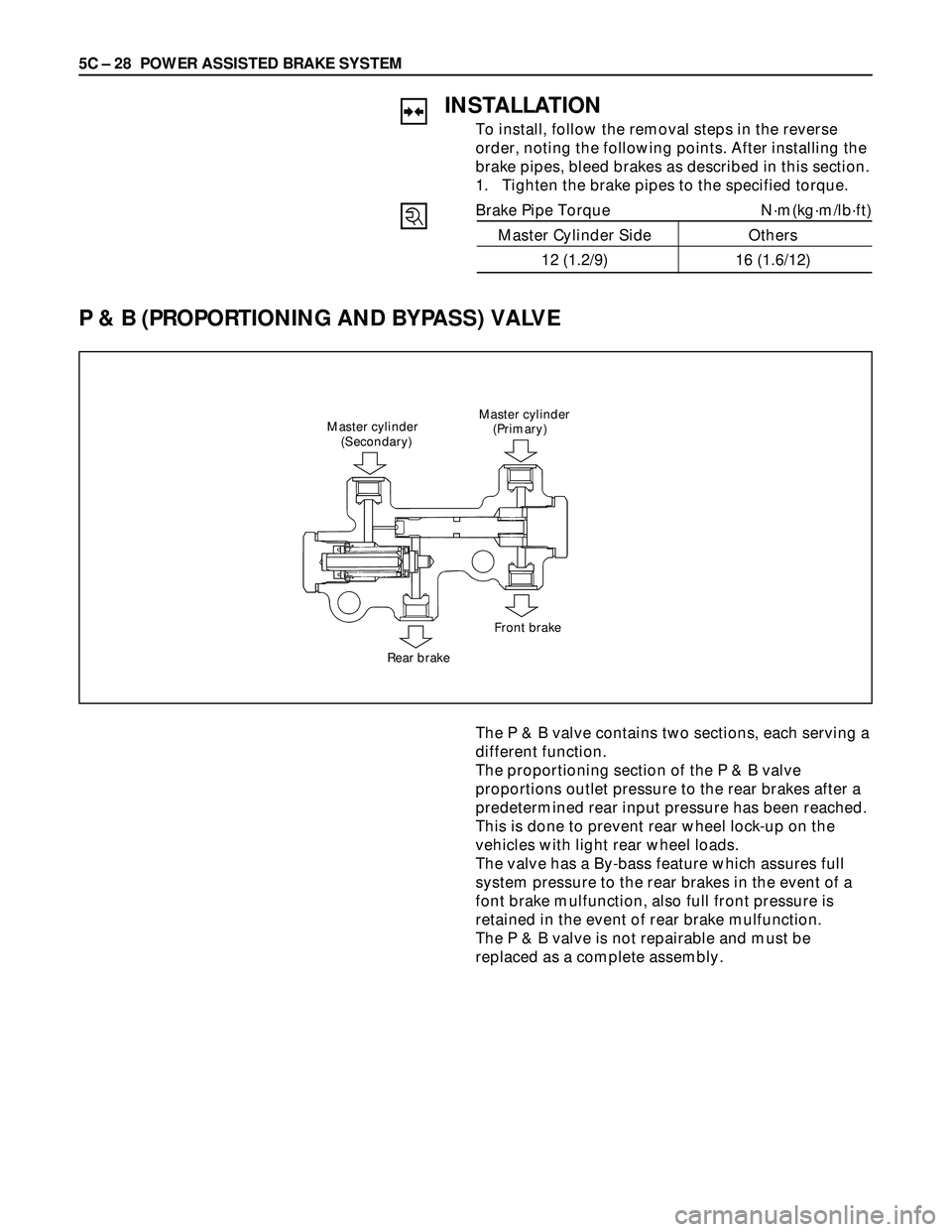
5C – 28 POWER ASSISTED BRAKE SYSTEM
P & B (PROPORTIONING AND BYPASS) VALVE
Master cylinder
(Primary) Master cylinder
(Secondary)
Rear brakeFront brake
INSTALLATION
To install, follow the removal steps in the reverse
order, noting the following points. After installing the
brake pipes, bleed brakes as described in this section.
1. Tighten the brake pipes to the specified torque.
Brake Pipe Torque N·m(kg·m/lb·ft)
Master Cylinder Side Others
12 (1.2/9) 16 (1.6/12)
The P & B valve contains two sections, each serving a
different function.
The proportioning section of the P & B valve
proportions outlet pressure to the rear brakes after a
predetermined rear input pressure has been reached.
This is done to prevent rear wheel lock-up on the
vehicles with light rear wheel loads.
The valve has a By-bass feature which assures full
system pressure to the rear brakes in the event of a
font brake mulfunction, also full front pressure is
retained in the event of rear brake mulfunction.
The P & B valve is not repairable and must be
replaced as a complete assembly.
Page 908 of 3573
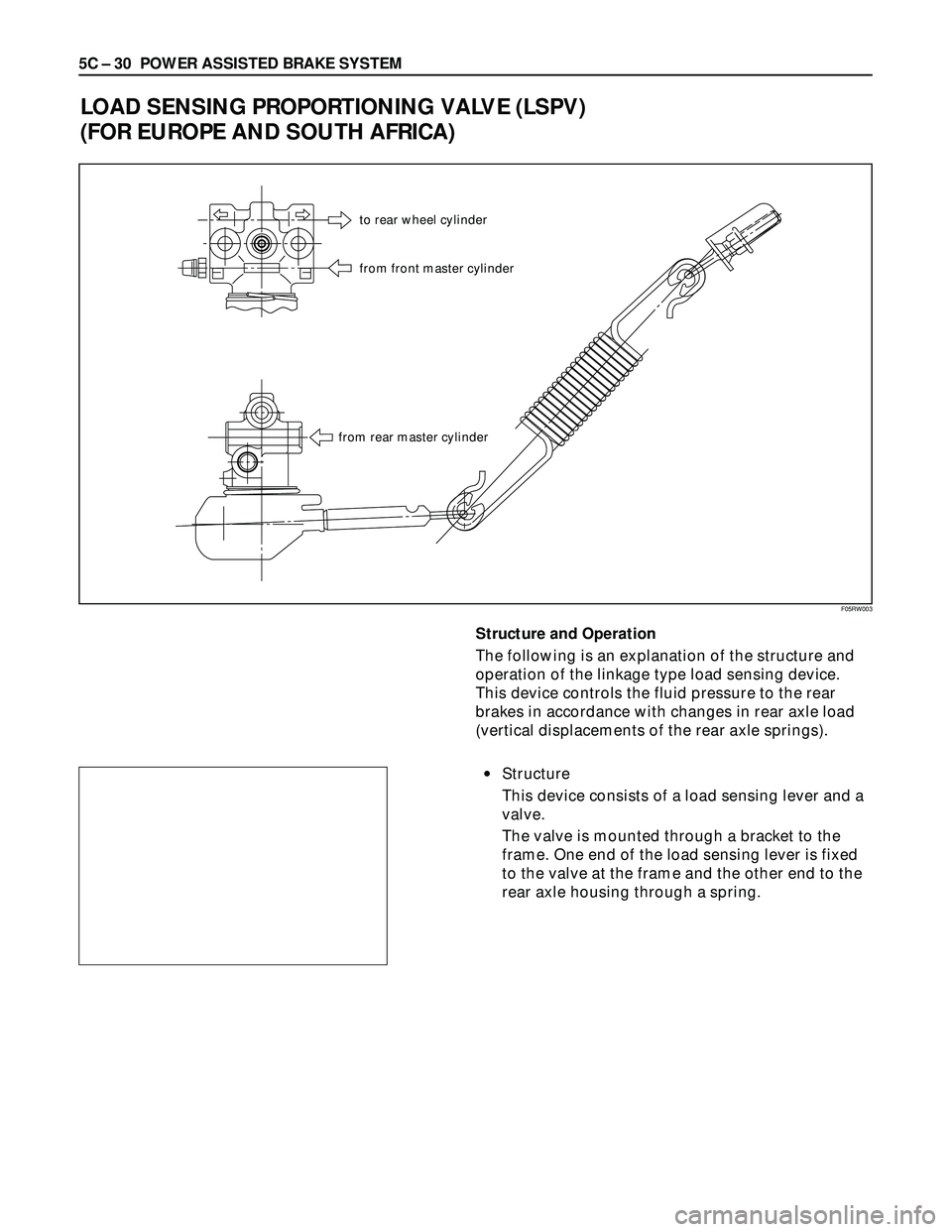
5C – 30 POWER ASSISTED BRAKE SYSTEM
LOAD SENSING PROPORTIONING VALVE (LSPV)
(FOR EUROPE AND SOUTH AFRICA)
to rear wheel cylinder
from front master cylinder
from rear master cylinder
Structure and Operation
The following is an explanation of the structure and
operation of the linkage type load sensing device.
This device controls the fluid pressure to the rear
brakes in accordance with changes in rear axle load
(vertical displacements of the rear axle springs).
•Structure
This device consists of a load sensing lever and a
valve.
The valve is mounted through a bracket to the
frame. One end of the load sensing lever is fixed
to the valve at the frame and the other end to the
rear axle housing through a spring.
F05RW003